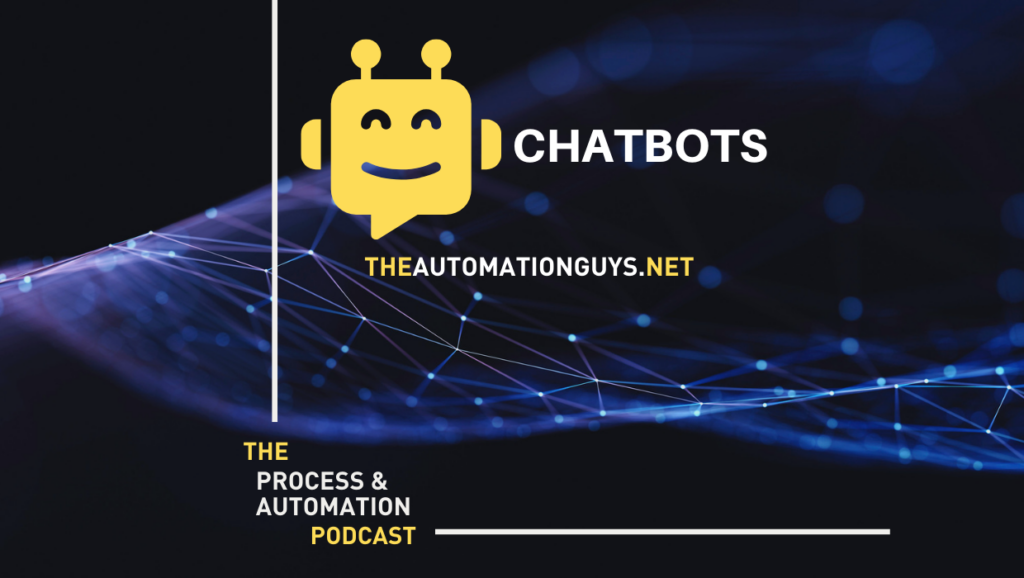Blog

Could 2022 be the year of the chatbots? In this episode of The Process and Automation podcast, The Automation Guys help you find out what chatbots can do for your business.
The #1 source of knowledge for everything automation: https://theautomationguys.net
Do you have any questions? Would you like to give us feedback? Are you interested in workshops on the topic of automation? Are you an expert in the field of automation and would like to be on the podcast? Let us know: https://bit.ly/3lyq9Yj
Share This Post
Episode Transcript
Sascha: Hello and welcome to another episode of The Process & Automation podcast. My name is Sascha Cutura, and with me here today is as usual Arno and together we are the automation guys. Um, yeah, every episode we have done so far as some somewhat related to our four main areas of intelligent automation.
Um, so, you know, we, we have talked about process mining, digital process automation, robotic process automation and artificial intelligence in general. So, um, yeah, and today we would like to jump back into one of our very popular topics, chatbots. Should we get to kick off with the first.
Arno: Yeah, sure.
Chatbots are these conversational agents that uses artificial intelligence to handle many routine queries and issues in your business. You know, and this of course includes marketing, order management, customer service. So those are usual sort of use cases for chatbots.
Um, you know, and with, with the definition of a chatbot or although it’s, it’s, it’s quite accurate it only really scratches the surfaces of what’s possible. Um, you know, when you bring these chatbots into your organization and really today, like you did in introduction, such a, we really want to sort of discuss some of the, I guess, the biggest myths and surprises about chatbots.
And the first one is you don’t need to code to create the chatbot. Now that sounds very strange, but reality is that chatbots are actually quite highly complicated entities and they simulate in natural languages like English in a very realistic manner. And what’s more, um, you know chatbots needs to be robust, um, to accept a wide range of potential user inputs.
So if you chat different things, you might have different ways of conversing with a chatbot. Um, So all of these factors might lead you to believe that you need a sort of a very advanced technical skillset to, to, to build a chatbot. But the good news is that this is far from the case. You know, these days there’s a variety of low code, no code chatbot solutions on the market.
And, you know, by using these chatbot platforms, you could drastically improve, improve your business, agility and decrease the time to market. And of course, you know, slash or software development you don’t need to go out there and hire very expensive, full time, uh, technical developers to, to, to create the chatbots.
You know, the, that, that the actual creation is, is a low-code journey, which is incredible. And you can build very, very complex, sophisticated chatbots solutions. So I think that’s, that’s one of our first top five things you, uh, you probably didn’t know about chatbots.
Sascha: Yeah, absolutely. So, so the next one, um, uh, we discussed a couple of times you’re on a podcast already a bit wider. And when we talked about use cases, so yeah, just make sure you, you go back a little bit on, on all our episodes. Um, we covered, covered a couple of use cases, um, uh, for chatbots. So, so that might be interesting as well.
So our chatbots aren’t only for customers. So nowadays. Yeah, it seems when you go on a website, uh, there is a chatbot already in the, in the right bottom corners as popping up, ready to answer any questions you have, um, and connect you with a human agent if necessary. So, so, so, and this, this seems like. It is only there for that use case.
Um, so if you have a question about your order or, um, you want to find out about the business, so that kind of stuff, like more FAQ kind of stuff. Yeah. Um, was this, uh, impression it’s easy to assume that chatbots are really meant to interact with customers, however, have a wider variety of use cases. Um, and not all of them are really customer facing.
For example, sales and marketing teams can use chatbots to assist with the lead generation efforts. And, um, know for example, as soon as the sales rep identifies a new prospect or have a new conversation with a customer you can have a conversation with the chatbot to input these details. Internally, you have a conversation with that chatbot, not any anyone externally. So this information is then immediately saved, um, um, by integration into a CRM or any other kind of software you have, um, in your, in your backend and other internal chat bots use cases might be, um, human resources, uh, operations management, and, um, and use cases for the finance.
Arno: Yes. So the third one that I want to touch on today is believe it or not but we seeing that customers increasingly prefer chatbots and prefer to interact with chatbots. Now, you know, they, they are plenty of internal use cases for chatbots, like you rightly said in, in HR, um, You know, chatbots itself are very highly successful at customer-facing roles.
Um, and you know, there are a variety of factors that plays into, um, you know, customers increasing acceptance of chatbot. So for instance, unlike the human support agents, chatbots can be available 24-7, 365 days a year to resolve routine customer service issues. Um, chatbots are for instance, available to start helping customers immediately rather than making them wait and very long queues to speak to a human agent.
And, you know, we seeing, you know, by, by deploying these chatbots to work on easily solvable issues and human agents can then spend more time with, um, you know, customers, who’s got more complicated problems, for example. And of course, you know, the fact is above assume that, you know, chatbots are well implemented, you know, and, and effective that they.
Um, so, so, so that’s why it’s very important to choose, the right chatbot technology and also the right chat bot implementation.
Sascha: If you have a question, you know, reach out to, to myself and to Arno and, um, we can really give you a deep dive on, on chatbots and, uh, additionally to the content we already provide to you in the, in the podcast.
Um, yeah, the next one we have chat bots can be used for purchasing. Um, we’ve mainly focused on support, use cases, customer facing chat, bots, that kind of stuff. But customers are growing increasingly comfortable with using chatbots to actually make a. Sort of purchases complete, um, sort of sign-ups registrations subscriptions, all that kind of stuff.
Yeah. So according to a survey, more than 20% of consumers, here in the UK would consider making a purchase through a chatbot. And, what’s more that this demographic will be willing to spend an average of 315 pounds on the chatbot enabled purchase. So that’s um, yeah, so all sorts of, uh, purchases you can, can visit normal, normal websites, clothing, or insurances, uh, even if it’s maybe the travel insurance or so it’s likely that these figures have only increased in the years since then.
Um, yeah. Um, as customers are getting really more and more comfortable shepherds and we are. As, as, as a generation, I think we are so comfortable with chatting. Isn’t it? WhatsApp, telegram, uh, everywhere has chat, um, uh, teams, Microsoft teams, slack. So everything is going towards that. And, uh, this is no surprise then that we actually getting more and more comfortable doing these purchases.
Arno: Yeah, and I think it is driving the adoption of chatbots. It’s easier to engage with the chat bot. The chat bots are very sophisticated because they’ve got really good artificial intelligence and natural language processing engines behind them. So people are a lot more confident and feel a lot more comfortable actually using chat bots to, um, do these purchases.
And you know, what’s a purchases is really easy and it’s seamless and it’s a good service. Um, that sort of underpants it. Um, you know, it is interesting that you did that. You mentioned the status on, on average people will be willing to spend about 315 pounds. So that’s almost $400 in a single transaction.
So if you make that easier in of course you can actually, um, increase the sales that comes through this channel. So kind of brings us to. Point that chatbots are on the rise. And, you know, the adoption of chatbots is soaring, you know, as more and more businesses come to realize their benefits. And, you know, I’m just gonna sort of share with our listeners a sort of a few facts and figures, um, that sort of backs that backs this up.
So in the, in the last year, um, 67% of consumers worldwide have interrupted. With a chat bot for customer support. Now that’s an incredible stat. Um, and again, you know, customer service is not the only use case for it, but the fact that such a large percentage of, uh, of a demographic actually use the chat board really, uh, tells us that, that you know, the adoption and people’s, um, you know, sort of usage of these chatbots are sort of increasing and, you know, people are feeling.
Uh, using these chatbots, um, there’s another stat where, um, by, uh, Gartner, which is of course, um, the it research and advisory firm that by next year, 70% of white collar workers will interact with conversational platforms on a daily basis. So this is where the chat is actually internal facing, you know, and again, 70% of, of, of workforce that that’s quite incredible.
And when you look at the global chatbot market, um, in 2015, it was only worth about a hundred million dollars. And, you know, by the end of 2024, they reckon it’s going to be worth round about a, a billion dollars. So there is clearly evidence that the adoption is on the rise. And I guess, you know, Uh, getting started with chatbots is quite easy.
It plugs quite easily into existing it infrastructure. Um, of course you’d have to, to build the bot, um, in a way that, um, you know, does, does the job correctly. Um, so they, there are certain, uh, you know, sequences that you need to, to, to build, but with, with the tools available out there, it’s all graphical.
It’s all very easy to assemble the chatbot to create the sort of rules and to train it to, to, um, you know, to do these, these sort of functions that, um, you know, you could push out to the different.
Sascha: Yeah, so it’s very easy to get started. And, um, uh, we, we just covered of on high level what shepherds can do, what you probably didn’t know about before.
Um, and we have a list of hundreds of use cases we can share with you. So yeah, just get in touch, with Arno and myself, and we can share that in directly with you in an individual session, just reach out on our social channels. And hopefully, so this, uh, this, this, um, short introduction overview, um, on chatbots, uh, was useful and, um, we would obviously welcome your feedback, um, and, uh, And then new ideas from, for maybe other episodes around chat bots or intelligent automation on our website, theautomationguys.net, you will find lots of resources and access to all the other episodes of our podcast.
That’s chatbots. And, um, that’s the end of our podcast today. And yeah, if you have any questions reach out and until then let’s automate.
Unfortunately, that’s it again with this episode of The Process and Automation podcast. If you liked this episode, please give us a five-star rating and don’t forget to subscribe to this podcast so you don’t miss any upcoming episode. We hope you will tune in next time and until then, let’s automate it.
- January 5, 2022
- 8:41 pm


